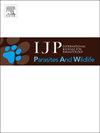津巴布韦Matebeleland地区野生反刍动物两栖动物形态与分子鉴定
IF 2.2
3区 医学
Q3 ECOLOGY
International Journal for Parasitology-Parasites and Wildlife
Pub Date : 2025-04-01
DOI:10.1016/j.ijppaw.2025.101065
引用次数: 0
摘要
两栖口病是一种对家畜和野生反刍动物的吸虫病知之甚少,其影响被低估了。迄今为止,关于两栖动物物种的分类学地位的信息有限,特别是在撒哈拉以南非洲,那里是多种感染家养和野生反刍动物的家园。鉴于此,在2019-2021年狩猎季节期间,在津巴布韦Matebeleland地区的Beitbridge、Nyamandlovu和Hwange的野生动物保护区和国家公园进行了一项调查。对329具野生反刍动物尸体进行了胃肠道感染检查,其中33/329(10%)动物感染,各地区感染率最高的是万基县(35%);7/20)。北桥地区的扁背水鸭(Kobus ellipsiprymnus)的感染率高达63%,每只动物的寄生负担高达1万多只。蓝角马(conchaetes taurinus taurinus)和黑貂(Hippotragus niger貂)的寄生负荷最低,均小于10只。随机选取非洲水牛(Syncerus caffer) 27份、黑斑羚(Aepyceros melampus) 17份、羚羊(Tragelaphus strepsiceros) 16份、水羚(n = 10份)、貂(n = 7份)、红背羚(Redunca arundinum) 7份、蓝角马(conchaetes taurinus taurinus) 2份两栖类标本86份,进行形态和分子鉴定。采用组织学技术和ITS-2 rDNA标记相结合的方法,鉴定了7种片石类;有袋形amphistix的leperocotyle gretillati、Calicophoron microbothrium、C. raja、C. clavula、C. phillerouxi、Gigantocotyle symmeri和Gastrothylax crumenifer。仅根据形态特征对其进行鉴定。虽然ITS-2是一种广泛使用的标记,但它可能不能用于判别Calicophoron属的隐种。dicranocoelium、G. crumenifer和L. gretillati是津巴布韦野生反刍动物的首次记录。本文章由计算机程序翻译,如有差异,请以英文原文为准。

Morphological and molecular identification of amphistomes of wild ruminants from selected conservancies of Matebeleland region of Zimbabwe
Amphistomosis is a poorly understood trematode disease of domestic and wild ruminants whose effect has been underestimated. To date, there is limited information on the taxonomic status of amphistome species, particularly in sub-Saharan Africa which is home to diverse species infecting domestic and wild ruminants. In view of this, a survey was conducted in wildlife conservancies and national parks located in Beitbridge, Nyamandlovu, and Hwange in the Matebeleland region of Zimbabwe during the 2019–2021 game hunting seasons. Gastrointestinal tract of 329 carcasses of wild ruminants were examined for amphistome infections and 33/329 (10 %) of the animals were infected and the highest prevalence per locality was in Hwange (35 %; 7/20). A high prevalence of 63 % was recorded in Kobus ellipsiprymnus (waterbuck) from Beitbridge, accompanied with a high parasitic burden of more than 10 000 parasites per animal. The lowest parasitic burden was observed in Connochaetes taurinus taurinus (blue wildebeest) and Hippotragus niger (sable), each with less than 10 amphistomes. A total of 86 amphistome specimens from Syncerus caffer (African buffalo) (n = 27), Aepyceros melampus (impala) (n = 17), Tragelaphus strepsiceros (kudu) (n = 16), waterbuck (n = 10), sable (n = 7), Redunca arundinum (reedbuck) (n = 7), and Connochaetes taurinus taurinus (blue wildebeest) (n = 2) were randomly selected for morphological and molecular identification. Using a combination of both histological technique and ITS-2 rDNA marker, the following seven amphistome species were identified; Leiperocotyle (L.) gretillati, Calicophoron (C.) microbothrium, C. raja, C. clavula, C. phillerouxi, Gigantocotyle (Gi.) symmeri, and Gastrothylax (G.) crumenifer which are pouched amphistome species. Orthocoelium dicranocoelium identification was based on morphological characters only. Although the ITS-2 is a widely used marker, it may not be useful in discriminating cryptic species in the Calicophoron genus. Orthocoelium (O.) dicranocoelium, G. crumenifer and L. gretillati are first records in wild ruminants in Zimbabwe.
求助全文
通过发布文献求助,成功后即可免费获取论文全文。
去求助
来源期刊

International Journal for Parasitology-Parasites and Wildlife
Medicine-Infectious Diseases
CiteScore
3.80
自引率
5.60%
发文量
113
审稿时长
45 days
期刊介绍:
The International Journal for Parasitology: Parasites and Wildlife (IJP-PAW) publishes the results of original research on parasites of all wildlife, invertebrate and vertebrate. This includes free-ranging, wild populations, as well as captive wildlife, semi-domesticated species (e.g. reindeer) and farmed populations of recently domesticated or wild-captured species (e.g. cultured fishes). Articles on all aspects of wildlife parasitology are welcomed including taxonomy, biodiversity and distribution, ecology and epidemiology, population biology and host-parasite relationships. The impact of parasites on the health and conservation of wildlife is seen as an important area covered by the journal especially the potential role of environmental factors, for example climate. Also important to the journal is ''one health'' and the nature of interactions between wildlife, people and domestic animals, including disease emergence and zoonoses.
 求助内容:
求助内容: 应助结果提醒方式:
应助结果提醒方式:


